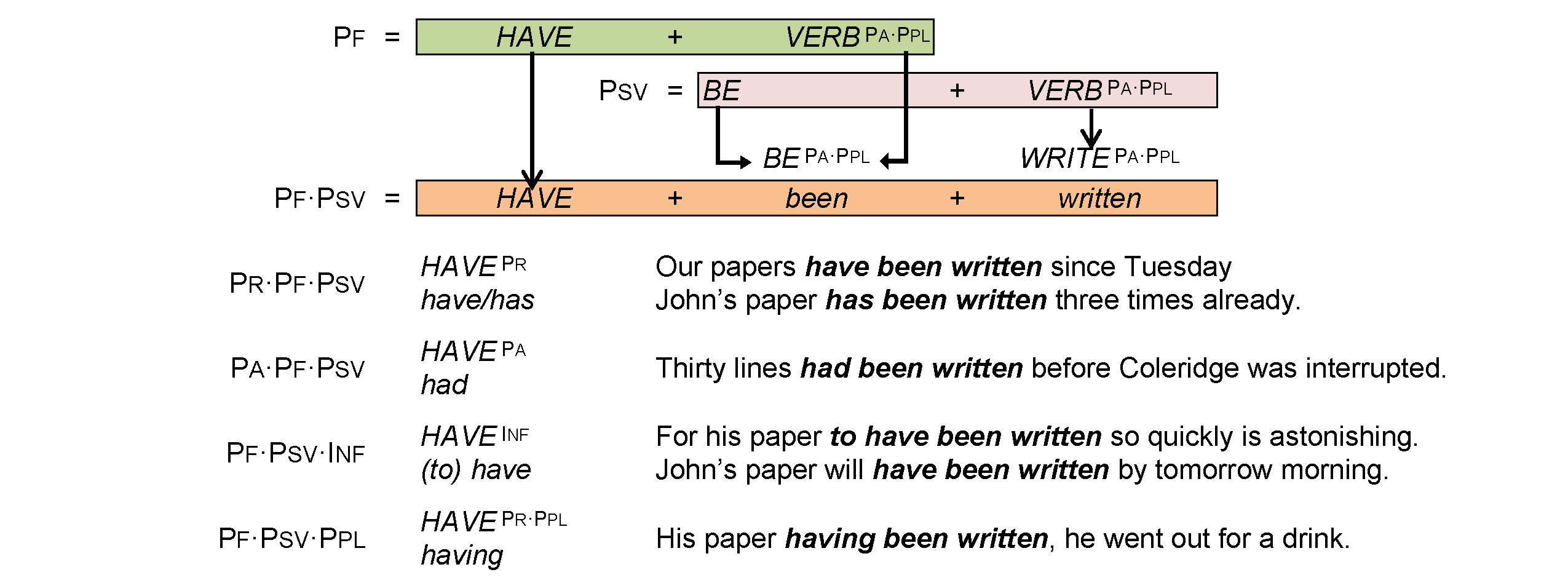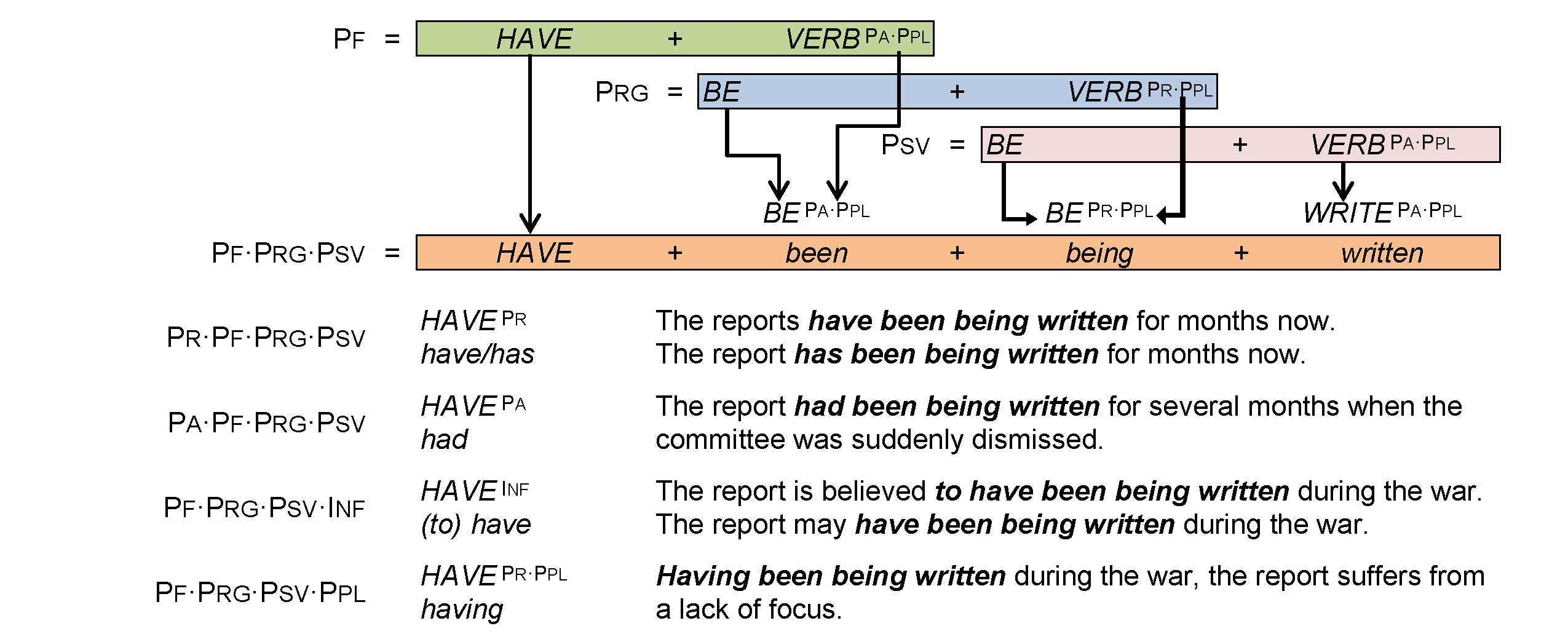Perfect constructions employ a form of HAVE as an auxiliary and the past participle of a lexical verb to express past events as a current state.
NOTE: Building perfect constructions requires that you understand the different forms a verb may take, what are often called its ‘principal parts’:
- the ‘infinitive (INF) form (identical with the 'present' form except with the verb BE)
- the ‘present’ (PR) form, and its 3d person singular variant (PR3)
- the ‘past’ (PA) form, sometimes called the -ed form
- the ‘present participle’ (PR·PPL), also called the ‘active participle’, ‘participle-gerund’, or -ing form
- the ‘past participle’ (PA·PPL), also called the ‘passive participle’ or -en form (in regular verbs, and some irregular verbs, identical with the 'past' form)
The Basic perfect (PF) construction
The English ‘perfects’ are a set of verb constructions which use a form of the auxiliary verb HAVE followed by the past participle (notated here as PA·PPL) of the following verb. In the ‘basic’ PF construction the following verb is the lexical verb (VERB), which is the verb which carries the ‘meaning’.
Here, for example, is how that works with the lexical verb WRITE:

Most forms of HAVE may be employed in this construction. Constructions employing a PR or PA ‘finite’ form are called the ‘present perfect’ (PR·PF) and ‘past perfect’ (PA·PF), respectively, and may be used wherever a finite verb is called for.

Constructions with the non-finite INF and PR·PPL forms of HAVE may be used like ordinary infinitives and present participles in subordinate clauses.

HAVE INF (have) may also be employed as the complement of modal verbs; when the modal verb is will the construction is called the ‘future perfect’ (FU·PF).
Coleridge may have written ‘Kubla Khan’ in 1797, 1798, or 1799.
I will have written my paper by next week.
But HAVE PR·PPL is never employed in the progressive (PRG) construction BE + PR·PPL:
∗Coleridge was having written ‘Kubla Khan’ in 1797, 1798, or 1799.
HAVE PA·PPL may of course act as the lexical verb (VERB) in the second position. In this case it has one of its ordinary senses, such as ‘possess’ or ‘experience’.
I have had a hard time with this essay.
Extended Pf constructions
PF constructions may also be combined with modal verbs (MODAL) and with progressive (PRG) and passive (PSV) constructions. The rules are basically very simple:
- These constructions follow a strict order: the MODAL component first, the PF component next, then the PRG, then the PSV, with VERB always at the end.
- Each construction is marked with a specific auxiliary verb, HAVE or BE, and there is a ‘ripple’ effect: the form (PPL or INF) of each of these verbs is determined by the preceding component.

If the HAVE form is preceded by a MODAL verb it must take the INF form, have. In all other cases the HAVE form is first. It can take any finite or non-finite form except the PA·PPL. It is always followed by the PA·PPL form of the next verb in the chain.
Perfect passive (PF·PSV) constructions
The basic PSV construction is built with a form of BE followed by the PA·PPL of VERB.

The PF·SV construction is therefore built as follows
- It starts with a form of HAVE.
- This is followed by the PA·PPL form of BE (been). That completes the PF part of the construction and starts the PSV part of the construction.
- The final element is the PA·PPL form of VERB. That completes the PSV part of the construction.

Perfect progressive (PF·PRG) constructions
The basic PRG construction is built with a form of BE followed by the PR·PPL, the –ing form, of VERB.

The PF·Prg construction is therefore built as follows:
- It starts with a form of HAVE.
- This is followed by the PA·PPL form of BE (been). That completes the PF part of the construction and starts the PRG part of the construction.
- The final element is the PR·PPL form of VERB. That completes the PRG part of the construction.

So the only difference between PF• PRG constructions and PF·PSV constructions is the form of the final VERB: an –ing form instead of a PA·PPL.
PF·Psv John has been praised by Bill.
PF·PRG John has been praising Bill.
Perfect progressive passive (PF·PRG· PSV) constructions
This construction combines the PF, PRG and PSV constructions:
- It starts with a form of HAVE.
- This is followed by the PA·PPL form of BE (been). That completes the PF part of the construction and starts the PRG part of the construction.
- This is followed by the PR·PPL form of BE (being). That completes the PRG part of the construction and starts the PSV part of the construction.
The final element is the PA·PPL form of VERB. That completes the PSV part of the construction.
There is rarely any occasion to use these complicated forms, and there is usually a simpler way to express the same thing. But for the sake of completeness, here are the construction and examples:

